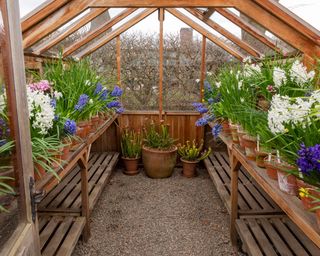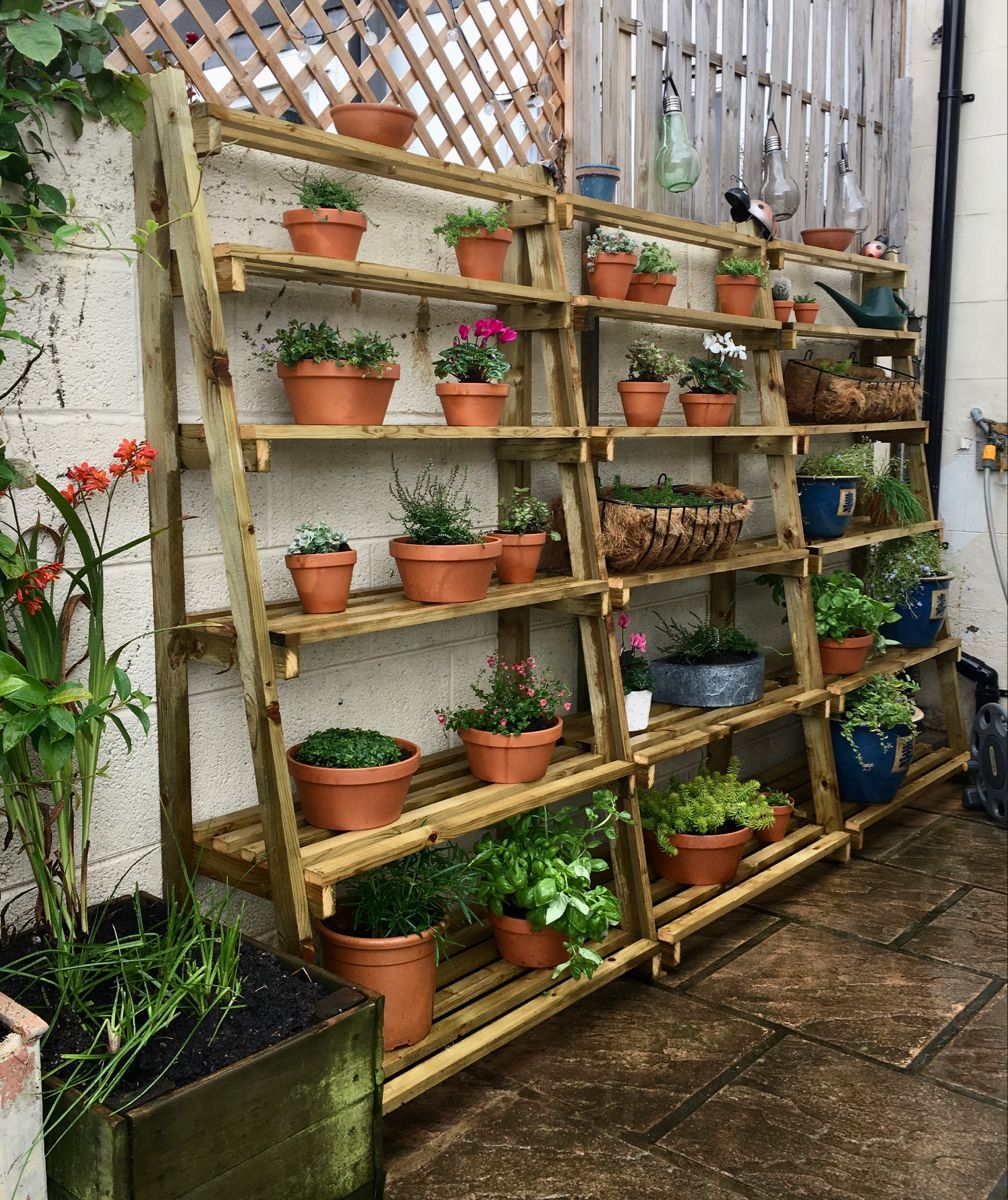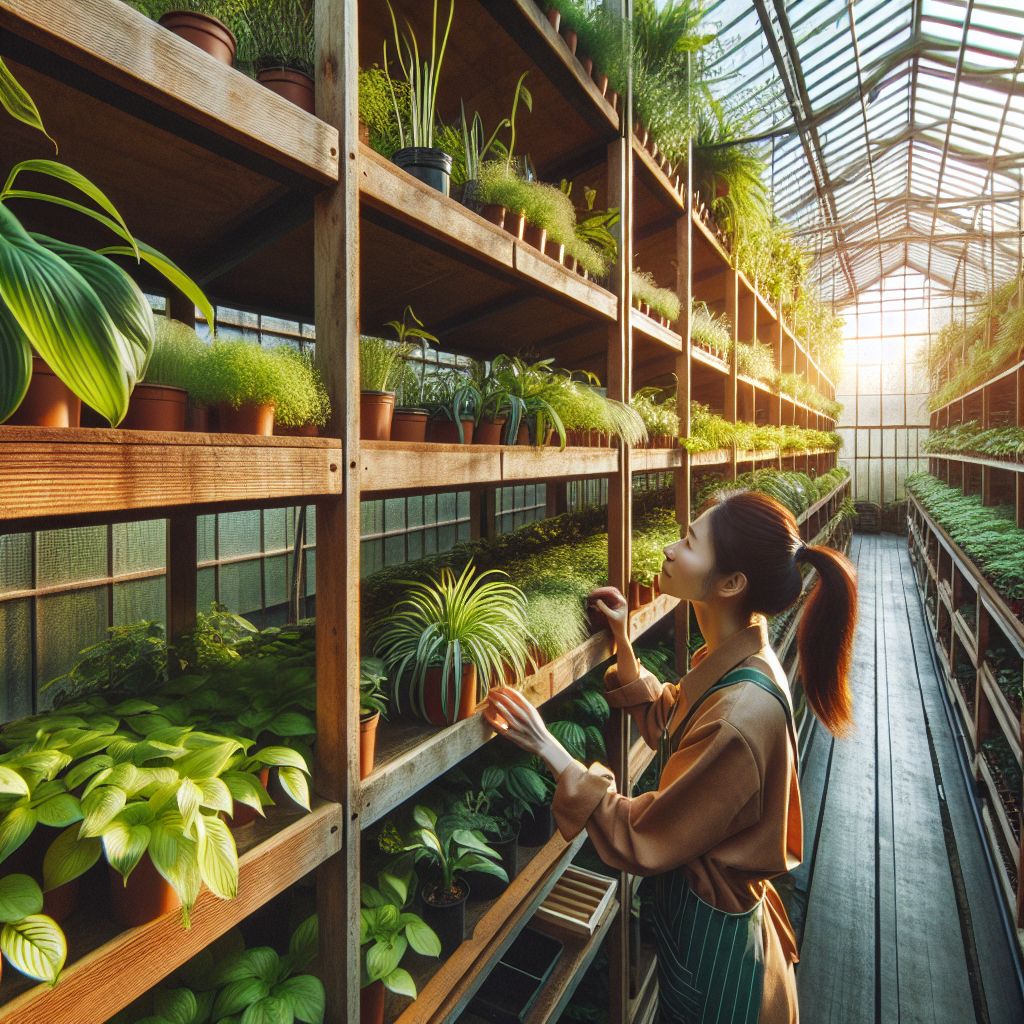Key Takeaways
-
DIY greenhouse shelving can maximize your vertical space, making your greenhouse more efficient.
-
Built-in wooden shelves are sturdy and customizable, perfect for heavy pots and tools.
-
Wire mesh shelving is lightweight and allows for excellent air circulation around your plants.
-
Rolling planter stands provide mobility, letting you rearrange your greenhouse layout easily.
-
Using pipes and fittings for shelves offers a flexible and modular approach to greenhouse organization.
DIY Greenhouse Shelving Ideas & Plans for Optimal Space
Optimize Your Greenhouse Space Efficiently
When it comes to making the most of your greenhouse, efficient use of space is crucial. Shelving is an essential component that can help you organize your plants, tools, and supplies effectively. By incorporating well-planned shelving, you can maximize vertical space, improve organization, and ensure your plants receive the best care possible.

“Greenhouse shelving ideas: 10 ways to …” from www.gardeningetc.com
Why Shelving is Essential for Greenhouses
Maximize Vertical Space
One of the primary benefits of greenhouse shelving is the ability to maximize vertical space. Instead of spreading plants out on the ground, you can stack them on shelves, making better use of the available area. This is especially important in smaller greenhouses where floor space is limited.
For example, using tiered shelving allows you to place smaller plants on top and larger ones on the bottom. This not only saves space but also ensures each plant gets adequate light and air circulation.
Improved Organization
Greenhouse shelving helps you keep everything in its place. When you have designated spots for your pots, tools, and supplies, you can easily find what you need without wasting time. Shelves can also be labeled to further enhance organization.
Besides that, an organized greenhouse makes it easier to maintain a clean and healthy environment for your plants. You can quickly spot any issues, such as pests or diseases, and address them promptly.
Healthier Plants
Proper shelving can contribute to healthier plants. By elevating plants off the ground, you reduce the risk of soil-borne diseases and pests. Additionally, shelves can be positioned to optimize light exposure, ensuring each plant gets the right amount of sunlight. For more tips, check out these greenhouse gardening tips.
Most importantly, good air circulation is essential for plant health. Shelving systems that allow for airflow around the plants help prevent mold and mildew growth, keeping your plants in top condition. For more information on maintaining your greenhouse, check out these summer greenhouse maintenance tips.
Popular DIY Greenhouse Shelving Ideas
Built-in Wooden Shelves
Built-in wooden shelves are a classic choice for greenhouses. They offer sturdiness and can be customized to fit your specific needs. Whether you want long, continuous shelves or individual units, wood is a versatile material that can handle heavy pots and tools.
To build wooden shelves, you’ll need the following materials:
-
2×4 or 2×6 lumber for the frame
-
Plywood for the shelves
-
Screws and brackets for assembly
-
Wood stain or paint for finishing
Start by measuring the space where you want to install the shelves. Cut the lumber to size and assemble the frame using screws and brackets. Attach the plywood to the frame to create the shelves, then finish with wood stain or paint to protect against moisture.
Wire Mesh Shelving
Wire mesh shelving is another excellent option for greenhouses. It’s lightweight, easy to install, and allows for great air circulation. This type of shelving is ideal for smaller plants and seedlings that need plenty of airflow.

To create wire mesh shelves, gather the following materials:
-
Wire mesh panels
-
Metal brackets or shelf supports
-
Zip ties or metal clips for securing the mesh
First, decide on the height and spacing of your shelves. Attach the metal brackets or supports to the greenhouse frame, then secure the wire mesh panels to the brackets using zip ties or metal clips. Make sure the shelves are level and stable before placing any plants on them.
Rolling Planter Stands
Rolling planter stands offer flexibility and mobility, making it easy to rearrange your greenhouse layout as needed. These stands typically have wheels and multiple tiers, allowing you to move plants around to optimize light and space. For more ideas on how to optimize your greenhouse, check out these greenhouse gardening tips.
Building a rolling planter stand requires the following materials:
-
Wood or metal for the frame
-
Plywood or wire mesh for the shelves
-
Casters or wheels
-
Screws and brackets for assembly
Start by constructing the frame using wood or metal. Attach the shelves to the frame, then secure the casters or wheels to the bottom. Ensure the stand is sturdy and can support the weight of your plants before use.
Container Farming Shelves
Container farming shelves are a smart way to utilize vertical space in your greenhouse. These shelves are designed to hold containers or pots of various sizes, making them perfect for growing a wide range of plants. By stacking containers on shelves, you can grow more plants in the same amount of space.
To create container farming shelves, you’ll need sturdy materials that can support the weight of multiple pots. Here are the materials required:
-
Wood or metal for the frame
-
Plywood or wire mesh for the shelves
-
Screws and brackets for assembly
Begin by measuring the space where you want to install the shelves. Cut the wood or metal to size and assemble the frame using screws and brackets. Attach the plywood or wire mesh to the frame to create the shelves. Ensure the shelves are level and secure before placing your containers on them. For more information on maintaining your greenhouse, check out these summer greenhouse maintenance tips.
Small Plant Stands on Wheels
Small plant stands on wheels are a great option for those who need to move their plants around frequently. These stands are typically compact and easy to maneuver, making them ideal for smaller greenhouses or indoor spaces. The wheels allow you to reposition your plants to ensure they receive the optimal amount of sunlight throughout the day. For more tips on maximizing your greenhouse space, check out these greenhouse gardening tips.
To build a small plant stand on wheels, you’ll need the following materials:
-
Wood or metal for the frame
-
Plywood or wire mesh for the shelves
-
Casters or wheels
-
Screws and brackets for assembly
Start by constructing the frame using wood or metal. Attach the shelves to the frame, then secure the casters or wheels to the bottom. Make sure the stand is sturdy and can support the weight of your plants before use.
Greenhouse Plant Ladder
A greenhouse plant ladder is a creative and space-efficient way to display your plants. This type of shelving system resembles a ladder, with multiple rungs or steps that hold pots and containers.

“Ladder garden shelves” from www.pinterest.co.uk
Plant ladders are perfect for small greenhouses or for adding a decorative touch to your plant arrangement.
To build a greenhouse plant ladder, you’ll need the following materials:
-
Wood for the ladder frame
-
Plywood for the steps
-
Screws and brackets for assembly
-
Wood stain or paint for finishing
Begin by cutting the wood to size for the ladder frame and steps. Assemble the frame using screws and brackets, ensuring the ladder is stable and secure. Attach the plywood steps to the frame, spacing them evenly. Finish with wood stain or paint to protect against moisture.
Step-by-Step Guide to Building DIY Greenhouse Shelving
Now that we’ve explored some popular DIY greenhouse shelving ideas, let’s dive into a step-by-step guide to building your own shelves. This guide will cover the materials required, tools needed, and the construction process to help you create functional and efficient shelving for your greenhouse.
Materials Required
Before you start building, gather all the necessary materials. The materials you’ll need will depend on the type of shelving you’re constructing. Here are some common materials used for DIY greenhouse shelving:
Wood and Plywood
Wood and plywood are versatile materials that can be used to create sturdy and customizable shelves. They are perfect for built-in shelves, plant ladders, and container farming shelves. When selecting wood, choose pressure-treated lumber to ensure it can withstand the humid greenhouse environment.
For plywood, opt for exterior-grade plywood, which is more resistant to moisture. Make sure to seal or paint the wood to protect it from rot and decay.
Wire Mesh
Wire mesh is an excellent material for greenhouse shelving because it allows for great air circulation and drainage. It’s lightweight and easy to install, making it ideal for smaller plants and seedlings. You can use wire mesh panels or shelves to create a flexible and functional shelving system.
Pipes and Fittings
Pipes and fittings offer a modular and customizable approach to greenhouse shelving. You can use PVC or metal pipes to create a framework for your shelves, then attach wooden or wire mesh shelves to the frame. This type of shelving is easy to assemble and can be adjusted to fit your specific needs. For more ideas on optimizing your greenhouse, check out these greenhouse gardening tips.
Tools Needed
Having the right tools is essential for building DIY greenhouse shelving. Here are some common tools you’ll need:
Saw and Drill
A saw is necessary for cutting wood, plywood, or pipes to the desired size. A drill is essential for making holes and driving screws during assembly. Make sure to use the appropriate blades and bits for the materials you’re working with.
Screwdriver and Screws
A screwdriver is needed to drive screws and secure the various components of your shelves. Choose screws that are suitable for the materials you’re using, such as wood screws for wooden shelves and metal screws for wire mesh shelves.
Construction Process
With your materials and tools ready, you can begin the construction process. Follow these steps to build your DIY greenhouse shelves:
Design and Planning
Start by designing your shelves and planning their layout in the greenhouse. Measure the available space and decide on the dimensions of your shelves. Sketch a rough design to help visualize the final product.
Assembly Instructions
Once you have a plan, cut the materials to size according to your design. Assemble the frame using screws and brackets, ensuring it is stable and secure. Attach the shelves to the frame, making sure they are level and evenly spaced. Double-check that all connections are tight and secure. For more ideas, check out these greenhouse shelving ideas.
Final Touches and Finishing
After assembling the shelves, apply any final touches such as sanding rough edges, sealing, or painting the wood. This will protect the shelves from moisture and enhance their appearance. Once the shelves are finished, you can start arranging your plants and supplies on them.
Remember to periodically inspect your shelves for any signs of damage or wear, and make any necessary repairs to ensure they remain safe and functional. For more detailed guidance, check out these summer greenhouse maintenance tips.

Assembly Instructions
Once you have a plan, cut the materials to size according to your design. Assemble the frame using screws and brackets, ensuring it is stable and secure. Attach the shelves to the frame, making sure they are level and evenly spaced. Double-check that all connections are tight and secure.
Final Touches and Finishing
After assembling the shelves, apply any final touches such as sanding rough edges, sealing, or painting the wood. This will protect the shelves from moisture and enhance their appearance. Once the shelves are finished, you can start arranging your plants and supplies on them.
Remember to periodically inspect your shelves for any signs of damage or wear, and make any necessary repairs to ensure they remain safe and functional. For more tips on maintaining a healthy growing environment, check out these greenhouse gardening tips.
Tips for Maintaining and Optimizing Greenhouse Shelving
To ensure your greenhouse shelves remain in top condition and continue to serve your needs effectively, regular maintenance is key. Here are some tips for maintaining and optimizing your greenhouse shelving:
Regular upkeep not only extends the lifespan of your shelves but also helps maintain a healthy environment for your plants. For more tips, check out these greenhouse gardening tips.
Regular Cleaning
Dust and debris can accumulate on your shelves over time. Regular cleaning prevents the buildup of dirt and helps maintain a healthy environment for your plants. Use a mild soap solution and a soft brush to clean the shelves, and rinse thoroughly with water.
Inspect for Damage
Periodically inspect your shelves for any signs of damage or wear. Look for loose screws, cracked wood, or rust on metal components. Address any issues promptly to prevent further damage and ensure the shelves remain safe and functional. For more tips on maintaining your greenhouse, check out these greenhouse gardening tips.
Seasonal Adjustments
Depending on the season, you may need to adjust the arrangement of your shelves and plants. For example, during the winter months, you might need to move plants closer to a heat source or provide additional insulation. In the summer, ensure proper ventilation and consider using shade cloth to protect plants from excessive heat.
Besides that, adjusting your shelves seasonally can help optimize light exposure and airflow, contributing to healthier plants.
Optimize Light Exposure
Proper light exposure is crucial for plant growth. Position your shelves in a way that maximizes natural light exposure. If necessary, supplement with artificial grow lights to ensure your plants receive adequate light, especially during the shorter days of winter.
Rotating Plants
Regularly rotating your plants ensures even light exposure and prevents overcrowding. This practice helps promote uniform growth and reduces the risk of pests and diseases. Rotate the plants on your shelves every few weeks to maintain optimal conditions.
Therefore, by following these maintenance tips, you can keep your greenhouse shelves in excellent condition and provide the best environment for your plants.
Conclusion
DIY greenhouse shelving is a practical and efficient way to optimize your greenhouse space. Whether you choose built-in wooden shelves, wire mesh shelving, rolling planter stands, or any other design, the key is to create a system that meets your specific needs and enhances the overall functionality of your greenhouse.
By following the step-by-step guide and maintenance tips provided in this article, you can build and maintain sturdy, functional, and attractive shelves that will help you grow healthy and thriving plants. Remember, a well-organized greenhouse is not only more efficient but also more enjoyable to work in.
Frequently Asked Questions (FAQ)
What materials are best for greenhouse shelving?
The best materials for greenhouse shelving depend on your specific needs and preferences. Wood and plywood are sturdy and customizable, making them ideal for heavy pots and tools. Wire mesh is lightweight and allows for excellent air circulation, perfect for smaller plants and seedlings. Pipes and fittings offer a flexible and modular approach to shelving. For more ideas, check out these greenhouse shelving ideas.
Can I use recycled materials for DIY greenhouse shelves?
Yes, you can use recycled materials for DIY greenhouse shelves. Reclaimed wood, metal, and other salvaged materials can be repurposed to create functional and eco-friendly shelving. Just ensure the materials are in good condition and suitable for the humid greenhouse environment.
How high should greenhouse shelves be?
The height of greenhouse shelves depends on the types of plants you are growing and the available space in your greenhouse. Generally, shelves should be spaced to allow enough room for plant growth and easy access. For most plants, shelves spaced 12 to 18 inches apart work well.
-
For smaller plants and seedlings, consider using tiered shelving with closer spacing.
-
Larger plants may require more space between shelves to accommodate their height.
Are rolling shelves practical for a greenhouse?
Rolling shelves are practical for a greenhouse, especially if you need to move plants around frequently. They offer flexibility and mobility, allowing you to rearrange your greenhouse layout as needed. Rolling shelves are ideal for optimizing light exposure and creating space for new plants.
Besides that, ensure the wheels or casters are sturdy and can support the weight of your plants to prevent accidents. For more tips on maintaining a healthy greenhouse, check out these greenhouse gardening tips.
